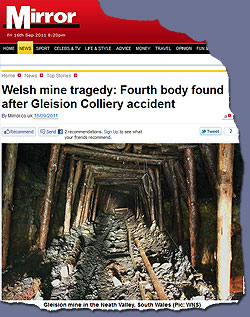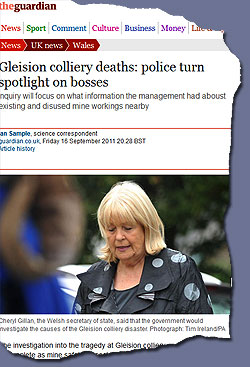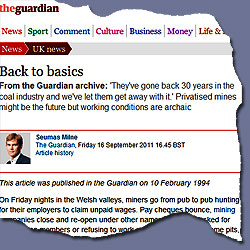Questions Over UK Safety Regime Follow Tragedy Of Welsh Miners Deaths
 With the bodies of the four miners killed in the Gleision mining disaster not yet recovered, questions over the safety regime in the UK’s private mines are already being raised.
With the bodies of the four miners killed in the Gleision mining disaster not yet recovered, questions over the safety regime in the UK’s private mines are already being raised.
The Guardian newspaper reports that the investigation is being done jointly by the police and local authorities with the support of the HSE.
The news item on the newspapers website Friday evening reports that:
“A spokeswoman for the HSE said the inspectorate's records showed no enforcement notices on the Gleision colliery, which was due an inspection later this year.
The inquiry will focus on what information the management of the colliery had about existing and disused mine workings in the vicinity. The law requires managers to employ a surveyor whose job it is to provide maps of nearby workings so miners can work a safe distance from them.
The HSE has specific regulations designed to prevent inrushes of water into mines. These make it the duty of the mine owner and manager to obtain all available information about nearby workings from the Coal Authority, where mine abandonment plans are filed, and to ensure that water inrushes do not happen.
But records of old mines are patchy. The failure of private mining companies to file abandonment plans in the early 20th century go some way to explain why people still fall down unknown mines today.”
In a further article regarding the deaths of the four miners in the Gleision mine, the National Union of Mineworkers is quoted to have serious concerns with regard to the safety in the country's privatised mines. They quote Chris Kitchen, general secretary of the NUM, as saying:
 "We have grave concerns about safety standards in these kinds of mines. We fear that safety is often set at minimum standards so that costs can be kept down. They are not generally unionised or easily visited by inspectors.
"We have grave concerns about safety standards in these kinds of mines. We fear that safety is often set at minimum standards so that costs can be kept down. They are not generally unionised or easily visited by inspectors.
Large mines, such as the five remaining deep underground mines which employ hundreds of workers, tend to operate under safety standards established when the industry was nationalised, up to 1995.
But the big collieries such as Kellingley in Yorkshire will typically have teams of dedicated fire and safety officers, surveyors and ventilation staff whose job it is to alert the owner and workforce to any problems. You are not going to have that kind of thing in a small drift mine that employs nine people."
Successive governments were warned as far back as 1994 regarding the health & safety of private mines in the UK following the smashing of the mining industry and its Trade Unions by Thatcher following the Miner’s Strike of 1984/85.
As is usual with privatisation and de-regulation, health & safety of the workforce takes second place to profits.
Today, with the backdrop of the mining disaster in the South Wales private mine, Gleision, resulting the death of 4 miners; The Guardian has republished Seumas Milne’s article first published on 10th February 1994. In it, the then state of the mining industry was examined with regard to both coal production and accident rates. Some clear warnings came out of the facts within the article:
“Underground, they stand in streams of water, hacking at the face with picks and shovels. Wooden roof props, phased out in publicly owned mines 40 years ago, are standard. Pit ponies haul rusting carloads of anthracite back and forth from the face. On the surface, there are no showers. The coal owners are back with a vengeance. This is private mining in 1994: the promised future of the British coal industry.”
Referencing the accident levels in 1993 he wrote:
“Last year, the fatal accident rate in privately owned mines was 23 times that in British Coal collieries. Government health and safety officials advise caution when comparing the public and private safety records because the smaller numbers in private mining can lead to sharp fluctuations in the fatality figures. So it seems fair to mention that the death rate in private mines was only seven times as high the year before.”
 Despite this, successive governments have proceeded with the destruction of the Coal mining industry in the UK by deregulation and wholesale transfer of mines to the private sector.
Despite this, successive governments have proceeded with the destruction of the Coal mining industry in the UK by deregulation and wholesale transfer of mines to the private sector.
Furthermore, those same governments have presided over the slashing of the HSE’s budgets and major cuts of inspectors have also continued to this day.
It doesn't’t take a genius to work out that a disaster such as that which took place this week at the Gleision mine in South Wales was inevitable.
But as the Guardian’ 1994 article shows, increases in the number of death’s of miners in UK’s private mines have occurred since the abolition of the British Coal Board.
The 1994 news article is none the less relevant today, especially when you consider the ConDem(ned) coalition governments public discrediting of all things health & safety as mere ‘red tape’ holding back business.
The final words are left with the Welsh secretary, Cheryl Gillan, who is quoted as saying the government would carry out "a full investigation into this terrible incident".
It remains to be seen as to how thorough and transparent such an investigation will be.
Source: The Guardian news website / Daily Mirror website